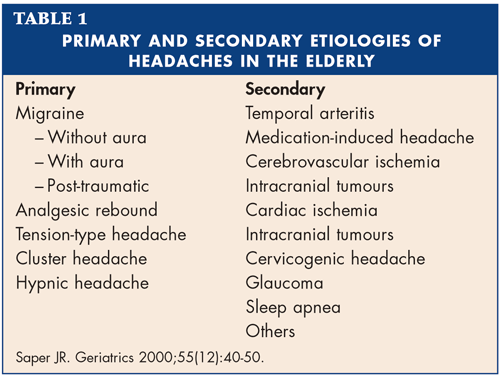Management of Headache in the Elderly Patient
D'Arcy Little, MD, CCFP
Director of Medical Education, York Community Services, Toronto, ON,
and Academic Fellow, Department of Family and Community Medicine,
University of Toronto, Toronto, ON.
Introduction and Epidemiology
While symptom complaints tend to increase as the population ages due to age and comorbid conditions, the prevalence of headaches actually decreases in the elderly compared to their younger counterparts.1,2,3 However, headache is still very common in this age group and causes significant morbidity. It is the 10th most common reported symptom in women, and the 14th most common symptom in men over the age of 65 living in the community.1,2,3 A large cohort study found that 11% of women over the age of 65 years and 5% of men over this age reported frequent headaches.1
While most (two-thirds of) headaches in the elderly result from benign causes such as tension-type, migraines and cluster headaches, one-third of headaches in this age group arise secondary to systemic disease and primary intracranial lesions.2,4 This is significantly different from the situation in younger patients, where only 10% of headaches are caused by such significant conditions (Table 1).2,4 Another difference in headaches between the young and old is the fact that even benign dysfunctional headaches (e.g. migraine, tension-type, cluster) can have an atypical presentation in the elderly.2 Furthermore, the elderly often have a reduced tolerance for medications, as well as more contraindications to medication due to concurrent medications and comorbidity.2 As a result, the diagnosis and treatment of headache in the elderly is challenging. This article will present an approach to this condition.

Approach to Diagnosis History and Physical Examination
It is uncommon for severe headaches to begin for the first time over the age of 50. In this situation, the patient will require a complete history and physical evaluation, including a comprehensive neurological examination, to exclude a secondary cause for the headache. While controversial, the use of CT or MRI imaging is advised by some experts, even in the setting of a normal neurological examination.2,3
Pertinent questions on history include features that suggest the possibility of a serious underlying cause. A headache of rapid onset or the worst headache of the patient's life suggests a subarachnoid hemorrhage. As mentioned, a new-onset headache in an older person, a progressive headache, a headache with confusion, seizures or altered level of consciousness, or a significant change in the frequency, severity or other clinical feature of a patient's usual pattern of headaches may also suggest a more serious etiology. Precipitation of the headache with a Valsalva manouevre (such as coughing or bending down) or the presence of focal neurologic symptoms might suggest a space occupying lesion. The presence of systemic symptoms such as fever, malaise, myalgias, scalp tenderness or jaw claudication might suggest polymyalgia rheumatica.4
The physical examination should include an assessment of blood pressure, heart rate and cardiac status. Extracranial structures such as sinuses, scalp arteries, cervical muscles (including range of motion), and temporomandibular joints should be assessed. Examination for meningeal irritation, bruits over the orbits or neck, fundi, visual fields pupillary reactions, cranial nerves, motor power in the face and extremities, deep tendon reflexes, plantar responses and gait should also be assessed. Any abnormalities suggest the need for further investigation.4
Laboratory Evaluation
In many cases, laboratory investigation may aid in the diagnosis of headache by revealing the nature of a contributing systemic illness. Depending on the situation, helpful lab tests may include: CBC, ESR, C-reactive protein, hepatic and renal function, electrolytes, calcium and serum drug levels, where appropriate. In some cases, arterial blood
